Direct intervention into the earth’s surface through technology – the coupling of the planet with technological objects – could be phrased as ‘geotechnical,’ a word I thought I invented – until I discovered that ‘geotechnics’ is already a long-standing professional concern of engineers and architects. Gone was the whiz-bang neologism, but born was an intense curiosity in what ‘geotechnical engineers’ actually do.
Unforeseen ground conditions. Reuse of old foundations. Ground investigation. Geological voids. Borehole geophysics. ‘Geo Frontiers 2005’. Ground engineering, which includes ‘international geotechnical events’ and ‘covers all aspects of the engineering of the ground’.
The vocabulary alone justifies awe. Where else can you read: ‘Sui Field compression project: the tectonic structure of Northern Pakistan’, and take it seriously?
Geosynthetics!
Ground improvement!
‘The geotechnics of contaminated land’!
Applied geology.
My enthusiasm coming here not from some pre-adolescent obsession with digging machines, but from the black-out inducing intellectual high of outright planetary engineering, a geosynthetic *Wunderproject*, where remote-sensing meets hydrological engineering, geotextiles, ground improvement, and mega-scale, antigravitational, interstellar industrial machines hovering 350 miles above the dark, unfinished surface of a geoengineered planet.
‘The engineering of the ground’!
After geotechnics, the whole planet could be already artificial, bearing marks of human intervention. To find in a moment of ultra-fast zoom-out cello-soundtracked awe that the earth you’re standing on is always, already, everywhere a huge Mt. Rushmore, a man-made, artificial, technological, geotechnic project.
A hollow earth, a geosynthetic planet. Sculpted from geotextiles.
Landscape architecture taken to the megalomaniacal extreme. And funded by multinational petroleum companies.
Author: Geoff Manaugh
Milled landscapes / Michael Heizer
The question is whether you could hook-up a milling machine to the earth itself. Rather than exact, laser-cut incisions made into boards of hardwood, you would mill entire landscapes out of the open surface of the earth.

This could start small – cutting foundations, bore holes, etc. – but should immediately expand to include larger examples of terrestrial engineering: landscape architecture, earthworks, gardens, perhaps even dikes, dams, and other flood containment systems. The earth-miller could be operated like an ordinary, programmable milling machine today: you input the design required, the exact sequence and dimensions of the cuts, and the machine sets out, milling a new landscape into existence.

In a recent *New York Times Magazine* profile of earthworks/land-sculptor Michael Heizer, we read about “‘City,’ [Heizer’s] own version of Easter Island or Angkor Wat: a modernist complex of abstract shapes – mounds, prismoids, ramps, pits – to be spread across the valley. It was to be experienced over time, in shifting weather, not from a single vantage point or from above but as an accumulation of impressions and views gathered by walking through it. (…) ‘City,’ in its vastness, was meant to synthesize ancient monuments, Minimalism and industrial technology. The work derived inspiration from Mississippian tumuli (ancient North American mounds), the ball court at Chichen Itza in the Yucatan and La Venta in southern Tabasco… At the same time, it suggested airport runways and Modernist architecture.” (Michael Kimmelman, “Art’s Last, Lonely Cowboy”: 6 Feb 05).

Despite – or perhaps because of – the size of Heizer’s “City” (somewhere between the Washington Mall and Central Park, apparently), it’d be perfect for an earth-miller. Several programmable machines with self-sharpening mechanical grinders, pavement saws and rock sanders – and perhaps viab/nozzles, mentioned in an earlier post – set to work. It takes days, weeks even, but then it’s done: the milled landscape of a new earth, abstract volumes glowing in the sunlight.

Lunar urbanism deux
The abstract of ‘Lunar architecture and urbanism’ by Brent Sherwood reads: ‘Human civilization and architecture have defined each other for over 5000 years on Earth. Even in the novel environment of space, persistent issues of human urbanism will eclipse, within a historically short time, the technical challenges of space settlement that dominate our current view. By adding modern topics in space engineering, planetology, life support, human factors, material invention, and conservation to their already renaissance array of expertise, urban designers can responsibly apply ancient, proven standards to the exciting new opportunities afforded by space. Inescapable facts about the Moon set real boundaries within which tenable lunar urbanism and its component architecture must eventually develop.’
Sherwood was/is with the NASA Goddard Space Flight Center. An otherwise so-so paper, published originally in 1992.
If only he knew about the viab/nozzle…
Lunar urbanism
Apparently ‘learning from nature’, François Roche and Behrokh Khoshnevis are working on a concrete spray-nozzle that ‘spits wet cement while a programmable trowel smoothes the goo into place’. They’re now wedding that with Roche’s own ‘viab’ device: ‘a construction robot capable of improvising as it assembles walls, ducts, cables, and pipes.’
They want to build skyscrapers on the moon.
There’s a movie coming out this summer called *Stealth* with Jamie Foxx that looks really, really bad. An AI bomber put to use by the Air Force – or Navy – gets struck by lightning, thereby rewiring its circuits into a predatory killing machine… What would be at least moderately more interesting, however, would be if a Roche/Khoshnevis viab/concrete nozzle assembly is struck by lightning, or perhaps reprogrammed by some strange shift in the local geomagnetic curtain: it thereafter starts building uninhabitably complex architectural structures out of a near-infinite supply of concrete from a nearby gravel plant. After only six days we’re talking Tower of Babel proportions. Soon you can see the results from six, seven, eight miles away; soon from the International Space Station.
A group of grad students volunteers to go out and waterproof it, sealing and perhaps painting it, and the autonomous viab/nozzle takes on literally mythic proportions. Soon Robert Pinsky, former Poet Laureate of these States, starts an epic poem based on the legend of Theseus and the Cretan labyrinth, rewriting it with the viab/nozzle as hero.
It just goes and goes and goes. Soon all of the American southwest is a hive of concrete. Skateboarders flock en masse to try out its arcs and curves, deep bowls and slopes perfect for next year’s X-Games. The galleries of New York fill with photographs and watercolors; avant-garde black-and-white films are released to great fanfare at European festivals; the President visits, complaining that it blocks access to resources vital to the extraction industry.
Soon the original – and real, mind you – purpose of the viab/nozzle is achieved: they are sent up to the moon, and Mars, and beyond – perhaps even to the bottom of the sea – in order to begin a more inhabitable, humanly useful construction.
They gaze back lovingly at the Earth, at the deserts of America, and the results of their ancestor’s first workings. The future origin myth for a race of interplanetary architect-machines.
(All quotations from Bruce Sterling, ‘An Architect’s Wet-Cement Dream’ in *Wired*, Feb 2005).
‘Animaris Mammoth’
At the risk of repeating another article, I’ll just quote liberally instead: Lakshmi Sandhana writes in *Wired* (24 Jan 05: *Wild Things Are on the Beach*) about Theo Jansen, an artist ‘evolving an entirely new line of animals: immense multi-legged walking critters designed to roam the Dutch coastline, feeding on gusts of wind.’ ‘His latest creations contain lemonade bottles in their body structure into which the wind is slowly pumped, enabling the creature to walk for a couple of minutes afterward. (…) He says a future version – a 12-ton behemoth, big enough to have several rooms inside – could be called the Animaris Mammoth.’
A friend of Jansen’s, Carl Pisaturo, another robotics designer, refers to a collapsed Jansenian creature as ‘a tipped-over, short-circuited machine half-buried in beach sand’ – surely outdoing the end of *Planet of the Apes*, or at least competing.
So could you do that with a building? It captures wind in huge flexible sacks that gradually return to normal size, pumping the air into a complex network of pneumatic tubing; these then power the elevators, vents, and whatever else you need. The plumbing perhaps. When you go through the doldrums of a windless Spring, the building effectively shuts down. But in a windstorm, you’d be forgiven for thinking the building was artificially intelligent. Constant motion, unpredictable internal rearrangements.
Artificial intelligence through wind. An architectural version of the Aeolian harp. Covered in sails and windsacs. A huge architectural lung, traveling slowly over the coastal landscape, fourteen thousand years after humans have gone extinct.
And then it collapses…
2 architectural suggestions for stopping time
While not ‘architectural,’ really – though I’m reminded of Norman Foster’s assertion that the 747 airplane is the single most important architectural design of the 20th century (giving a whole new perspective to September 11th: it was an architectural competition, and the skyscraper lost) – two architectural suggestions for stopping time are as follows:
1) Build a solar-powered airplane and fly it at exactly the speed of the rotation of the earth, against the earth’s rotation. Do this at high-noon, over the equator. The plane will always be in the glow of the sun, never leaving its precise and comfortable position at high-noon. Having become a geostationary structure in a low-atmosphere orbit, the airplane, barring mechanical failure, will never advance forward in time. It will always be noon, technically on the same day. It will be architecture that’s seceded from the aging of the universe.
2) Build a box of perfectly reflective internal surfaces. Light will never be absorbed or dissipated, but endlessly recycled and returned through the box’s mirrored interior. Whatever moment it captures – that is, whatever was happening when the box was sealed: the event, or location, that bounced its reflective way into the box’s hermetic closure – will remain in a constant state of cross-reflection, never dissipating or fading. The image, a kind of 3-dimensional holograph of the event it refers to, can then be sent floating outward from the earth, drifting through space, reflecting, never aging, one moment stuttering through itself over and over again till universal heat-death does us in.
And in both cases – within those two spatial instances, those two pieces of ‘architecture’ – time will effectively be stopped.
(Or so he tells himself.)
bldgblog-as-soundbite
We have more to learn from the fiction of J.G. Ballard and the international warehousing strategies of Bechtel than we do from Le Corbusier. The good city form of tomorrow is a refugee camp built by Brown & Root; the world’s largest architectural client is the U.S. Department of Defense. More people now live in overseas military camps than in houses designed by Mies van der Rohe – yet we study Mies van der Rohe.
Buttressed buttresses
First, whenever I hear the phrase ‘buttressed buttresses’ I think of Boutros-Boutros Ghali. Perhaps to his credit.
Second, the actual point in bringing up (inventing?) the phrase, is that even buttresses can have buttresses. Buttresses, the spidery, ribcage-like stone arches that stand outside cathedrals and hold up the walls of the nave, have always fascinated me, both on the aesthetic level (they’re gorgeous, and absolutely beautiful to look at in their hypnotic repetition and grace) and on the intellectual level. They are, after all, fun to think about it: because they’re not really objects, they’re events. They’re events of gravity channeled downward toward the earth’s core; they’re the building always on the verge of falling apart – and then not falling apart.
They’re somewhere between event and structure.
But what really interests me is to think that you’re visiting Paris, say, or some other city that has no name and, strangely, no one’s ever heard of it, and you’re standing in the apartment of a friend. There’s a rather large arching stone structure that cuts through the center of his bedroom, but he’s done his best to adapt to it: there are pictures, maybe some cool decorative objects, maybe some shelves, all attached with nails into the arch. You say, ‘What exactly is that thing, anyway?’ and he grins, embarrassed, and he says, ‘It’s a buttress.’
You go, ‘What?’ and hold back a yawn, looking around for a place to sit.
He starts laughing. He says, ‘Come on, dude, you know what a buttress is. It’s like those – those big fucking things you see outside Notre-Dame. Those spidery, ribcage-like stone arches that stand outside cathedrals.’
‘Oh,’ you say. ‘So… what’s it doing in your apartment?’
It turns out, as the man explains, you friend, standing there looking at you with a beer in his hand, that there’s a monumental structure in the center of the city, a derrick-like core of platforms and offices, and it’s called, simply, The Cathedral. Or The Tower. But it’s big, so big, so incomprehensibly massive, that the only way it can remain standing is to surround itself with massive buttresses that help distribute the gravitational load. The buttresses themselves, on the other hand, are so huge that they were put to dual use almost immediately as motorway bridges and highway flyover supports; but then the weight of the motorways, and of cars and trains and people and maybe some houses built atop the buttresses – and, of course, the weight of The Cathedral itself – was all too much, and the buttresses needed to be buttressed. But, as you can imagine, even these subsidiary buttresses were so huge that they, too, were put to dual use; and so on.
Finally, in an exquisite filigree stretching everywhere throughout the city, a mandala of lace-like interconnected structures that spans the width and breadth of the whole metropolis: there begin to appear thousands upon thousands of microbuttresses, all buttressing the buttresses that buttress the buttresses.
And what you see there in your friend’s apartment is one of those microbuttresses.
Buttressed buttresses.
There are pubs in the city set in the vertices of two dozen arches; new children’s games invented to incorporate the presence of strange structural blocks; and there are dreams at night, shared by everyone, at different times, that even The Cathedral in the center of the city is itself a buttress, and it, too, is just one structural unit among uncountable hundreds of thousands, all of which add up to some dizzyingly titanic megastructure no one has ever seen the whole of.
My point is not to write a science-fiction novel – though I might, actually, so be prepared – but to explore the idea that even buttresses have buttresses; even foundations have foundations; even arches need arches to support them. Even one buttress, after all, requires the resistance and strength of the ground it’s anchored upon; and that ground depends upon the strength of the ground around it. Which makes earthquake faultlines so interesting, as an architectural consideration, but that’s for another entry.
But the chain never ends. Buttresses simply make visible the always present gravitational forces so well disguised by other styles of building, and, as such, they’re amazing.
What would be even more interesting, perhaps, is: you are out walking in a field and you stumble upon a strange architectural structure, only it has no doors or windows, ie. no inside. You’re twenty, thirty miles away from any metropolitan center, and you have no clue what it is. You’re in a bad mood. You begin to hack away at it, and then finally you just say fuck it, and you drive a Hummer into it. It falls over.
You think that’s the end of it, but then you hear that a cathedral has collapsed in the nearest city, and it collapsed because suddenly one of its outer buttresses gave out. It turns out that, yes, the now-collapsed buttress was reliant upon the compressive and resistant capacity of the soil it was anchored in, and that that structure you knocked over, thirty miles away, was very carefully calibrated as a brace for that soil. By knocking it over you let the earth sag, in a straight line leading right to the cathedral, and voilà: architectural action at a distance.
It’s the magical mystery of buttressed buttresses.
The Physics, The Flux, The Architecture
‘Think only of the essentials: the physics of the gyroscope, the flux of photons, the architecture of very large structures.’ J.G. Ballard
Maunsell Towers Sea Forts
Speaking of Gunkanjima Island… There’s also the Maunsell Towers:
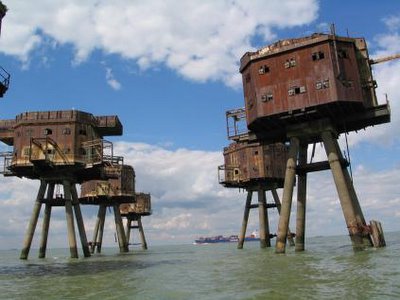
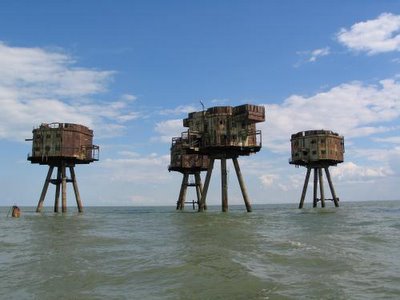
“The [Maunsell Towers] Thames Estuary Army Forts were constructed in 1942 to a design by Guy Maunsell, following the successful construction and deployment of the Naval Sea Forts. Their purpose was to provide anti-aircraft fire within the Thames Estuary area. Each fort consisted of a group of seven towers with a walkway connecting them all to the central control tower.” Constant’s Babylon meets the economic mobilization of WWII. These look like a cross between the Empire’s attack-convoy robot-walker things in *The Empire Strikes Back* and, yes, Constant’s Babylon:
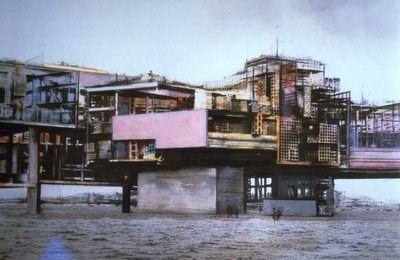
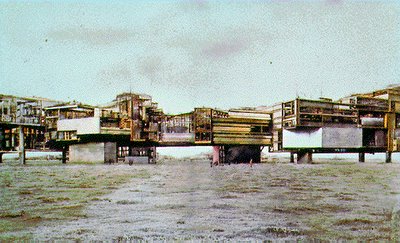
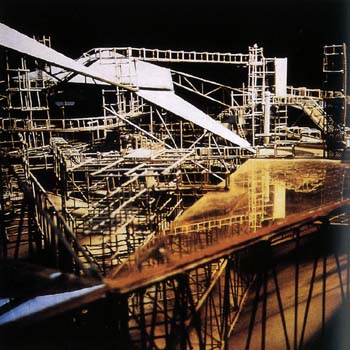
As such, these are dying to be used in a film.
Another site verges on the illiterate, but it’s clearly enthusiastic, and explains the towers’ construction.
Glass is the ice of sand
As a continuation of the previous post, imagine a house whose plans are based upon a photomicrograph of glass. The house’s actual lay-out and external appearance are exact translations of the mineral structure and microtectonics of glass. The house itself, though, is also a glass house; that is, even as its layout and structure are based upon the mineral tectonics of glass itself, the house uses glass as its primary material.
Now imagine a Charles & Ray Eames-like film where we zoom-in at powers of 10 till we end up on the photomicrographic level, looking at the glass that the house is constructed from: the only problem is that it looks exactly like a full-scale photograph of the house. Have we zoomed all the way in, or did we zoom all the way back out?




MC Escher meets Mies van der Rohe, perhaps. Or Ouroborus as an architectural condition. And what happens if we keep zooming in?
Scalar interchangeability.